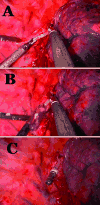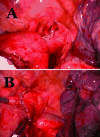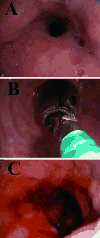A safe and reproducible anastomotic technique for minimally invasive Ivor Lewis oesophagectomy: the circular-stapled anastomosis with the trans-oral anvil
- PMID: 20153660
- PMCID: PMC2878854
- DOI: 10.1016/j.ejcts.2010.01.010
A safe and reproducible anastomotic technique for minimally invasive Ivor Lewis oesophagectomy: the circular-stapled anastomosis with the trans-oral anvil
Abstract
Objectives: In expert hands, the intrathoracic oesophago-gastric anastamosis usually provides a low rate of strictures and leaks. However, anastomoses can be technically challenging and time consuming when minimally invasive techniques are used. We present our preliminary results of a standardised 25 mm/4.8mm circular-stapled anastomosis using a trans-orally placed anvil.
Materials and methods: We evaluated a prospective cohort of 37 consecutive patients offered minimally invasive Ivor Lewis oesophagectomy at a tertiary referral centre. The oesophago-gastric anastomosis was created using a 25-mm anvil (Orvil, Autosuture, Norwalk, CT, USA) passed trans-orally, in a tilted position, and connected to a 90-cm long polyvinyl chloride delivery tube through an opening in the oesophageal stump. The anastomosis was completed by joining the anvil to a circular stapler (end-to-end anastomosis stapler (EEA XL) 25 mm with 4.8-mm staples, Autosuture, Norwalk, CT, USA) inserted into the gastric conduit. Primary outcomes were leak and stricture rates.
Results: Thirty-seven patients (mean age 65 years) with distal oesophageal adenocarcinoma (n=29), squamous cell cancer (n=5) or high-grade dysplasia in Barrett's oesophagus (n=3) underwent an Ivor Lewis oesophagectomy between October 2007 and August 2009. The abdominal portion was operated laparoscopically in 30 patients (81.1%). The thoracic portion was done using a muscle-sparing mini-thoracotomy in 23 patients (62.2%) and thoracoscopic techniques in 14 patients (37.8%). There were no intra-operative technical failures of the anastomosis or deaths. Five patients had strictures (13.5%) and all were successfully treated with endoscopic dilations. One patient had an anastomotic leak (2.7%) that was successfully treated by re-operation and endoscopic stenting of the anastomosis.
Discussion: The circular-stapled anastomosis with the trans-oral anvil allows for an efficient, safe and reproducible anastomosis. This straightforward technique is particularly suited to the completely minimally invasive Ivor Lewis oesophagectomy.
Copyright 2010 European Association for Cardio-Thoracic Surgery. Published by Elsevier B.V. All rights reserved.
Figures




Similar articles
-
Minimally invasive intrathoracic anastomosis after Ivor Lewis esophagectomy for cancer: a review of transoral or transthoracic use of staplers.Surg Endosc. 2012 Jul;26(7):1795-802. doi: 10.1007/s00464-012-2149-z. Epub 2012 Feb 1. Surg Endosc. 2012. PMID: 22294057 Free PMC article. Review.
-
[Abdominothoracic esophageal resection according to Ivor Lewis with intrathoracic anastomosis : standardized totally minimally invasive technique].Chirurg. 2015 May;86(5):468-75. doi: 10.1007/s00104-014-2786-y. Chirurg. 2015. PMID: 24994588 German.
-
Combined laparoscopic and thoracoscopic Ivor Lewis esophagectomy for esophageal cancer: initial experience from China.Chin Med J (Engl). 2012 Apr;125(8):1376-80. Chin Med J (Engl). 2012. PMID: 22613638
-
[Robot-assisted Minimally Invasive Oesophagectomy - Surgical Variants of Intrathoracic Circular Stapled Oesophagogastric Anastomosis].Zentralbl Chir. 2023 Feb;148(1):19-23. doi: 10.1055/a-1838-5170. Epub 2022 Jun 28. Zentralbl Chir. 2023. PMID: 35764303 German.
-
Optimal oesophagogastric anastomosis techniques for oesophageal cancer surgery - A systematic review and network meta-analysis of randomised clinical trials.Eur J Surg Oncol. 2025 May;51(5):109600. doi: 10.1016/j.ejso.2025.109600. Epub 2025 Jan 20. Eur J Surg Oncol. 2025. PMID: 39884090
Cited by
-
Minimally invasive intrathoracic anastomosis after Ivor Lewis esophagectomy for cancer: a review of transoral or transthoracic use of staplers.Surg Endosc. 2012 Jul;26(7):1795-802. doi: 10.1007/s00464-012-2149-z. Epub 2012 Feb 1. Surg Endosc. 2012. PMID: 22294057 Free PMC article. Review.
-
Double stapling technique versus hemi-double stapling technique for esophagojejunostomy with OrVil™ after laparoscopic total gastrectomy: a single-blind, randomized clinical trial.Surg Endosc. 2023 Aug;37(8):5931-5942. doi: 10.1007/s00464-023-10068-z. Epub 2023 Apr 19. Surg Endosc. 2023. PMID: 37076615 Clinical Trial.
-
The Advances of Laparoscopic Gastrectomy for Gastric Cancer.Gastroenterol Res Pract. 2017;2017:9278469. doi: 10.1155/2017/9278469. Epub 2017 Sep 5. Gastroenterol Res Pract. 2017. PMID: 29018482 Free PMC article. Review.
-
Thoracoscopic purse string technique for minimally invasive Ivor Lewis esophagectomy.J Thorac Dis. 2014 Feb;6(2):148-51. doi: 10.3978/j.issn.2072-1439.2013.12.27. J Thorac Dis. 2014. PMID: 24605229 Free PMC article.
-
[Abdominothoracic esophageal resection according to Ivor Lewis with intrathoracic anastomosis : standardized totally minimally invasive technique].Chirurg. 2015 May;86(5):468-75. doi: 10.1007/s00104-014-2786-y. Chirurg. 2015. PMID: 24994588 German.
References
-
- Pera M, Manterola C, Vidal O, Grande L. Epidemiology of esophageal adenocarcinoma. J Surg Oncol. 2005;92(3):151–159. - PubMed
-
- Altorki NK, Zhou XK, Stiles B, Port JL, Paul S, Lee PC, Mazumdar M. Total number of resected lymph nodes predicts survival in esophageal cancer. Ann Surg. 2008;248(2):221–226. - PubMed
-
- Santillan AA, Farma JM, Meredith KL, Shah NR, Kelley ST. Minimally invasive surgery for esophageal cancer. J Natl Compr Canc Netw. 2008;6(9):879–884. - PubMed
-
- Craig SR, Walker WS, Cameron EW, Wightman AJ. A prospective randomized study comparing stapled with handsewn oesophagogastric anastomoses. J R Coll Surg Edinb. 1996;41(1):17–19. - PubMed
Publication types
MeSH terms
Grants and funding
LinkOut - more resources
Full Text Sources
Medical

